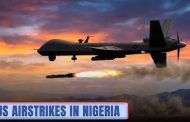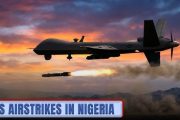New data from SIPRI’s Arms Industry Database shows that arms sales by the world’s 25 largest arms-producing and military services companies (arms companies) totalled US$361 billion in 2019. This represents an 8.5 per cent increase in real terms over the arms sales of the top 25 arms companies in 2018. This is the latest information coming from the Swedish think tank, the Stockholm International Peace Research Institute, (SIPRI).
In a press statement December 7th, 2020 on “Mapping the International Presence of the World’s Largest Arms Companies”, the think tank is alerting the world that the largest companies involved have a geographically diverse international presence.
Intervention has slightly re-arranged the sequence of the press statement and accompanying details but retained the wording used by SIPRI. It goes as follows:
This year, SIPRI is releasing its data set on the arms sales of the world’s largest arms companies along with the results of a mapping exercise on the internationalization of the arms industry. For this, a new data set was created, comprising 400 subsidiaries, joint ventures and research facilities linked to the top 15 arms companies in 2019. Sources of data included company investment filings, information on company websites, public registrars and news articles. To be included in the mapping, an entity had to have been active for the majority of the 2019 fiscal year; be located in a country other than the one in which its parent company has its headquarters; and (a) manufacture military goods or provide military services to military customers; or (b) manufacture, or provide services for, dual-use goods to military customers.
The mapping shows that the international presence of major arms companies continues to be influenced by geopolitical divisions and ties, and generally mirrors the geographical locations of the world’s biggest arms import markets. It also reveals that the international presence of major Chinese arms companies and the one Russian company included in the study remains limited.
US companies still dominate, Middle East represented in top 25 for the first time
In 2019 the top five arms companies were all based in the United States: Lockheed Martin, Boeing, Northrop Grumman, Raytheon and General Dynamics. These five together registered $166 billion in annual arms sales. In total, 12 US companies appear in the top 25 for 2019, accounting for 61 per cent of the combined arms sales of the top 25.
For the first time, a Middle Eastern firm appears in the top 25 ranking. EDGE, based in the United Arab Emirates (UAE), was created in 2019 from the merger of more than 25 smaller companies. It ranks at number 22 and accounted for 1.3 per cent of total arms sales of the top 25.
‘EDGE is a good illustration of how the combination of high national demand for military products and services with a desire to become less dependent on foreign suppliers is driving the growth of arms companies in the Middle East,’ said Pieter Wezeman, Senior Researcher with the SIPRI Arms and Military Expenditure Programme.
Another newcomer in the top 25 in 2019 was L3Harris Technologies (ranked 10th). It was created through the merger of two US companies that were both in the top 25 in 2018: Harris Corporation and L3 Technologies.
Chinese arms companies’ sales increase, Russian companies’ sales fall
The top 25 also includes four Chinese companies. Three are in the top 10: Aviation Industry Corporation of China (AVIC; ranked 6th), China Electronics Technology Group Corporation (CETC; ranked 8th) and China North Industries Group Corporation (NORINCO; ranked 9th). The combined revenue of the four Chinese companies in the top 25—which also include China South Industries Group Corporation (CSGC; ranked 24th)—grew by 4.8 per cent between 2018 and 2019.
Reflecting on the rise in the arms sales of Chinese companies, SIPRI Senior Researcher Nan Tian said: ‘Chinese arms companies are benefiting from military modernization programmes for the People’s Liberation Army.’
The revenues of the two Russian companies in the top 25—Almaz-Antey and United Shipbuilding—both decreased between 2018 and 2019, by a combined total of $634 million. A third Russian company, United Aircraft, lost $1.3 billion in sales and dropped out of the top 25 in 2019.
Alexandra Kuimova, Researcher at SIPRI, said: ‘Domestic competition and reduced government spending on fleet modernization were two of the main challenges for United Shipbuilding in 2019.’
Other notable developments and trends in the top 25
After the USA, China accounted for the second largest share of 2019 arms sales by the top 25 arms companies, at 16 per cent. The six West European companies together accounted for 18 per cent. The two Russian companies in the ranking accounted for 3.9 per cent.
Nineteen of the top 25 arms companies increased their arms sales in 2019 compared with 2018. The largest absolute increase in arms revenue was registered by Lockheed Martin: $5.1 billion, equivalent to 11 per cent in real terms.
The largest percentage increase in annual arms sales—105 per cent—was reported by French producer Dassault Aviation Group. ‘A sharp rise in export deliveries of Rafale combat aircraft pushed Dassault Aviation into the top 25 arms companies for the first time,’ says Lucie Béraud-Sudreau, Director of the SIPRI Arms and Military Expenditure Programme.
Mapping shows Global South becoming integrated into global arms industry
The report also looks at the international presence of the 15 largest arms companies in 2019. These companies are present in a total of 49 countries, through majority-owned subsidiaries, joint ventures and research facilities.
With a global presence spanning 24 countries each, Thales and Airbus are the two most internationalized companies—followed closely by Boeing (21 countries), Leonardo (21 countries) and Lockheed Martin (19 countries).
The United Kingdom, Australia, the USA, Canada and Germany host the largest numbers of these foreign entities. Outside the arms industry hubs of North America and Western Europe, the largest numbers of entities of foreign companies are hosted by Australia (38), Saudi Arabia (24), India (13), Singapore (11), the UAE (11) and Brazil (10).
Alexandra Marksteiner of the SIPRI Arms and Military Expenditure Programme said: ‘There are many reasons why arms companies might want to establish themselves overseas, including better access to growing markets, collaborative weapon programmes, or policies in the host countries tying arms purchases to technology transfers.’
Of the 49 countries hosting foreign entities of the top 15 arms companies, 17 are in low- and middle-income countries. ‘Countries in the Global South seeking to jump-start their arms production programmes have welcomed foreign arms companies as a means to benefit from technology transfers,’ said Diego Lopes da Silva, Researcher at SIPRI.
Siemon Wezeman, Senior Researcher at SIPRI, said: ‘The Chinese and Russian arms companies in the top 15 have only a limited international presence. Sanctions against Russian firms and government-mandated limits on acquisitions by Chinese firms seem to have played a role in constraining their global presence.’
Arms companies have a presence that reaches far beyond the countries in which they are headquartered. This is the result of the internationalization of the arms industry. This paper uses a new data set to examine the results of this internationalization in terms of the international presence of major arms companies. It presents a mapping comprising 400 foreign entities linked to the world’s largest arms companies.
This is the first of three major data launches in the lead-up to the publication of SIPRI’s flagship publication in mid-2021, the annual SIPRI Yearbook. Ahead of this, SIPRI will release its international arms transfers data (details of all international transfers of major arms in 2020) as well as its world military expenditure data (comprehensive information on global, regional and national trends in military spending)




























